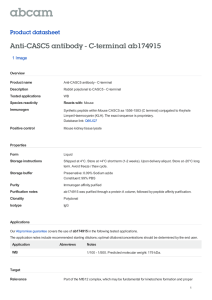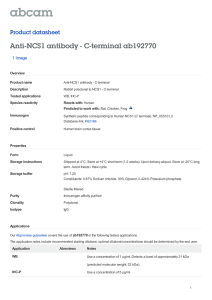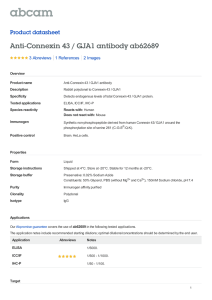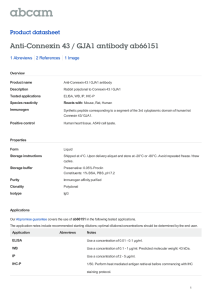Anti-GJB3 antibody - C-terminal ab139378 Product datasheet 1 Image Overview
advertisement
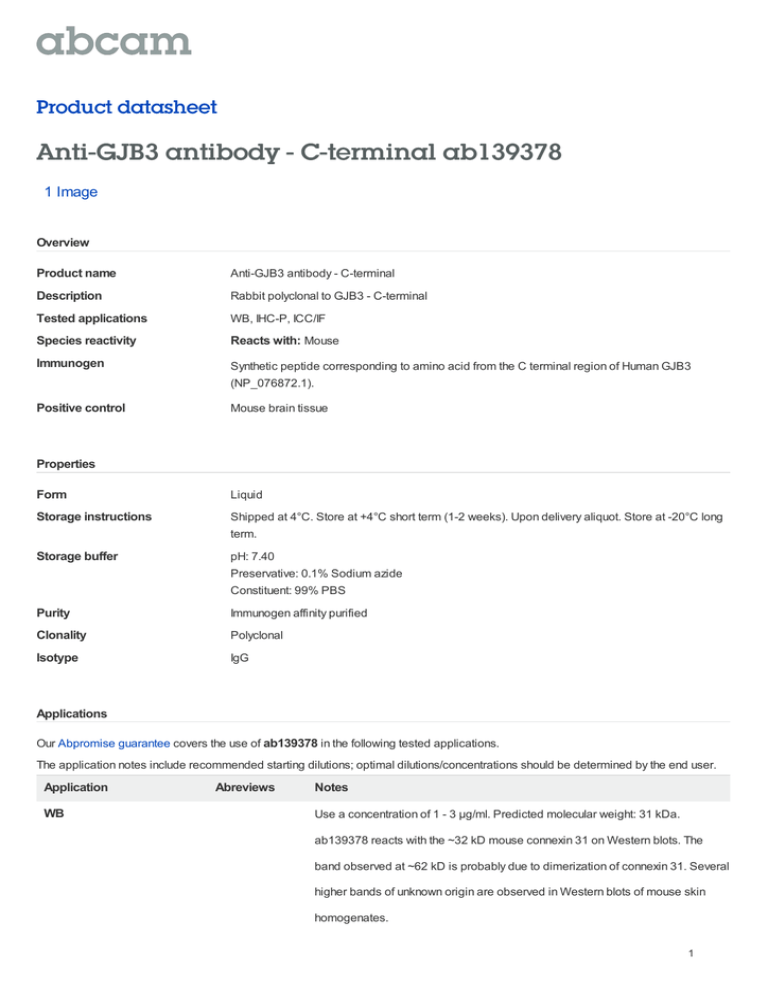
Product datasheet Anti-GJB3 antibody - C-terminal ab139378 1 Image Overview Product name Anti-GJB3 antibody - C-terminal Description Rabbit polyclonal to GJB3 - C-terminal Tested applications WB, IHC-P, ICC/IF Species reactivity Reacts with: Mouse Immunogen Synthetic peptide corresponding to amino acid from the C terminal region of Human GJB3 (NP_076872.1). Positive control Mouse brain tissue Properties Form Liquid Storage instructions Shipped at 4°C. Store at +4°C short term (1-2 weeks). Upon delivery aliquot. Store at -20°C long term. Storage buffer pH: 7.40 Preservative: 0.1% Sodium azide Constituent: 99% PBS Purity Immunogen affinity purified Clonality Polyclonal Isotype IgG Applications Our Abpromise guarantee covers the use of ab139378 in the following tested applications. The application notes include recommended starting dilutions; optimal dilutions/concentrations should be determined by the end user. Application WB Abreviews Notes Use a concentration of 1 - 3 µg/ml. Predicted molecular weight: 31 kDa. ab139378 reacts with the ~32 kD mouse connexin 31 on Western blots. The band observed at ~62 kD is probably due to dimerization of connexin 31. Several higher bands of unknown origin are observed in Western blots of mouse skin homogenates. 1 Application Abreviews IHC-P Notes Use a concentration of 5 µg/ml. Perform heat mediated antigen retrieval with citrate buffer pH 6 before commencing with IHC staining protocol. ICC/IF Use a concentration of 1 - 3 µg/ml. Target Function One gap junction consists of a cluster of closely packed pairs of transmembrane channels, the connexons, through which materials of low MW diffuse from one cell to a neighboring cell. Involvement in disease Defects in GJB3 are a cause of erythrokeratodermia variabilis (EKV) [MIM:133200]. EKV is a genodermatosis characterized by the appearance of two independent skin lesions: transient figurate erythematous patches and hyperkeratosis that is usually localized but occasionally occurs in its generalized form. Clinical presentation varies significantly within a family and from one family to another. Palmoplantar keratoderma is present in around 50% of cases. Defects in GJB3 are the cause of deafness autosomal dominant type 2B (DFNA2B) [MIM:612644]. DFNA2 is a form of sensorineural hearing loss. Sensorineural deafness results from damage to the neural receptors of the inner ear, the nerve pathways to the brain, or the area of the brain that receives sound information. Sequence similarities Belongs to the connexin family. Beta-type (group I) subfamily. Cellular localization Cell membrane. Cell junction > gap junction. Anti-GJB3 antibody - C-terminal images Immunohistochemical analysis of formalin fixed, paraffin embedded mouse brain tissue, labeling GJB3 with ab139378 at 5 µg/ml. Immunohistochemistry (Formalin/PFA-fixed paraffin-embedded sections) - Anti-GJB3 antibody (ab139378) Please note: All products are "FOR RESEARCH USE ONLY AND ARE NOT INTENDED FOR DIAGNOSTIC OR THERAPEUTIC USE" Our Abpromise to you: Quality guaranteed and expert technical support Replacement or refund for products not performing as stated on the datasheet Valid for 12 months from date of delivery Response to your inquiry within 24 hours We provide support in Chinese, English, French, German, Japanese and Spanish Extensive multi-media technical resources to help you 2 We investigate all quality concerns to ensure our products perform to the highest standards If the product does not perform as described on this datasheet, we will offer a refund or replacement. For full details of the Abpromise, please visit http://www.abcam.com/abpromise or contact our technical team. Terms and conditions Guarantee only valid for products bought direct from Abcam or one of our authorized distributors 3
